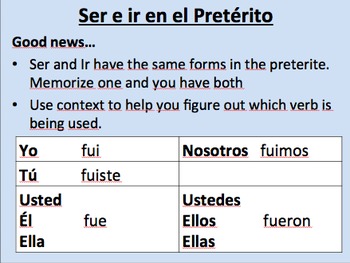
Let’s see the proper conjugation for the previously mentioned verbs : Subject
#Preterite endings ir plus
Other verbs that require a similar change.Ĥ) Irregular Preterite Verbs Ending In -UCIRĪll Spanish verbs ending in -ucir, such as: conducir (to drive), producir (to produce), traducir (to translate), etc, plus the verbs traer (to bring) and decir (to say), have the following endings in the preterite: Subject Let’s see some examples of these changes applied in the preterite tense. The required stem change can be summarized into two groups, according to its changes: Changes in Preterite tense Verbs ending in -IR that changes stem in the simple present tense, will also change in the preterite, but only for the personal pronouns: él,ella,usted,ustedes,ellos,ellas. However, once the stem changes, you can use the same preterite endings for all regular IR verbs.īefore we elaborate on this, let’s review the endings for IR verbs in the preterite tense. IR verbs that change stems in the simple present tense also require a change in the preterite. Relatively straightforward, no? 3) Irregular Preterite Verbs Ending In -IR Once you learn these endings, simply add them to the new stem for the verb you wish to use. This group of verbs undergo a stem change when conjugated in the preterite, but use the same endings that are shown in the table below. 2) Irregular Preterite Verbs That Have Stem Changes, But Regular Endings The good news is the following verbs follow certain patterns, making them easier to memorize. Moving on, we can look at steam changing verbs in the preterite. I was his neighbor for many years – Fui su vecino por muchos años.I went to see my neighbor – Fui a ver a mi vecino.The only time it doesn’t need a preposition is when a location is already mentioned – usually naming a physical place. While this may seem confusing, a reasonably easy and effective trick to tell both verbs apart is to remember that the verb Ir is used when something moves somewhere else, and so it will most likely include prepositions such as the “a”, or alternatively “para”. Hopefully, you noticed that Ser and Ir verbs have identical conjugations in the preterite. These five verbs are probably the most commonly used irregular verbs in the preterite, and so it’s important to memorize the conjugations by heart. In other words, they are completely irregular as they do not follow any pattern whatsoever. These verbs belong in the wild west of conjugations.


#Preterite endings ir how to
Recommended: How to Learn Spanish Fast in 2023ġ) Verbs that require significant changes

Past tense Spanish is something that tends to confuse many Spanish students, especially when dealing with irregular preterite verbs.

Have conversations faster, understand people when they speak fast, and other tested tips to learn faster.
#Preterite endings ir free
Get our free email course, Shortcut to Conversational.


 0 kommentar(er)
0 kommentar(er)
